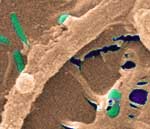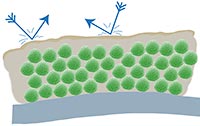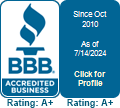Biofilms and recurring infections

The bacteria (green shapes) are covered by a protective “biofilm” (tan). Biofilms render many therapies, especially antibiotics, ineffective.
Biofilms are thin armored fortresses that bacteria build to live, breed and hide inside. While bacteria are too small to see without a microscope, you probably see biofilms every day without even realizing it. One type of biofilm is the slimy layer inside your pet’s water dish that’s so hard to clean off. Another biofilm is the hard dental plaque that develops on your teeth. Biofilms are tenacious and tough, shielding the bacteria from the outside environment.
Bacteria often form biofilms inside your body. Biofilms are linked to many types of stubborn recurring Staph and MRSA infections.
Biofilms: a hard nut to crack
Antibiotics have a hard time penetrating a biofilm to kill the bacteria inside. It’s like trying to kill a colony of bees by spraying the ones flying in the air. Unless you also spray the hive, the bees will be back again in no time. In the same way, unless you can destroy the biofilm itself, it’s easy to get stuck in a cycle of recurring infections.

Biofilms are like shields that protect bacteria from attacking antibiotics and other treatments. Biofilms also help bacteria to stick to medical implants, tissues and other surfaces.
The National Institute for Health (NIH) says that biofilms are implicated in up to 80% of all chronic, recurring infections. And Staph bacteria are a major player when it comes to creating biofilms. How do you know if you have a biofilm infection? As a rule of thumb, experts say if have you a surgically implanted device or prosthetic that is infected, or if you have a history of recurring infections, there’s a good chance that a biofilm infection is involved.
Biofilms are a relatively new area of research and few relevant treatment studies have been performed. Most tests for both MRSA natural remedies and MRSA antibiotic drugs are done using free-floating bacteria, not biofilms. And biofilms are much more impervious to treatments and your own immune system than free-floating bacteria.
What can you do about biofilms?
Studies show that several natural remedies have activity against biofilms, including medicinal herbal blends and Manuka honey. Some natural products also have had a very good track record when it comes to stopping chronic recurring infections. It makes sense that plants and natural products can have biofilm fighting abilities. Plants have to defend themselves against bacterial invasion in natural would have to develope anti-biofilm compounds to defend against this threat.
There are even compounds being developed specifically to break down biofilms and make other treatments work better. More research should be done on plant compounds and “biofilm buster” compounds because standard treatments (like antibiotics) have little or no effect.
One of the best ways to ward off biofilms is your immune system, which is your first line of defense against any infection. Bacteria hiding in biofilms are just waiting for a good opportunity to cause a re-infection. You can give bacteria less opportunities to cause re-infection by keeping your immune system strong.

- Key steps to controlling recurring infections.
- What can you do if you’re frustrated with your doctor?
- Why does MRSA and Staph often recur over and over?





